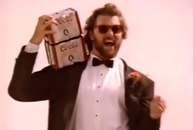To the extent that "up for whatever" can be called a strategy, that's where the problem lies.
The beer business in general, and the light-beer business in particular, has long enjoyed the benefits of "party consumption." Light beer really is the perfect alcohol beverage for a night, a day, or an afternoon of continued partying. The lower alcohol content means the human body can ingest more 12-ounce beers before the drinker "feels full," industry code for gets buzzed, lit, or flat-out, fall-down drunk. On the one hand, lower alcohol levels might be considered a good thing, but on the other, it's that longer-drinking aspect inherent in any party strategy that'll stumble into the social-consciousnss tripwire.
Boom.
It's all happened before.
Back in the 80s, while Miller Lite continued the great-taste-less-filling advertising that created the light-beer category, upstarts Bud Light and Coors Light both discovered the light-beer = party axiom. These two brands' growth trajectories accelerated dramatically. It could be argued the momentum gained from their decisions to "party" is a big reason both brands ultimately passed Miller Lite.
Déjà vu, all over again
From a marketing standpoint, it's easy to see Bud Light's "up for whatever" campaign as an attempt to resurrect its wildly successful 1980s appeal. Heck, all the milennials weren't even born back then! And times do change, don't they? Craft breweries pushing brands like "All Day" and "Wake Up Dead" with no push-back might've even lured the Bud Light guys into a sense that the coast was clear. A night without "no" is just a great a party, right?
But even so, having seen one of the most successful beer-advertising icons ever, Spuds MacKenzie, lynched at the hands of an outraged, offended, socially conscious mob, the Bud Light brain trust ought to have been worried about history repeating itself.
But they weren't. And it did.




 RSS Feed
RSS Feed
